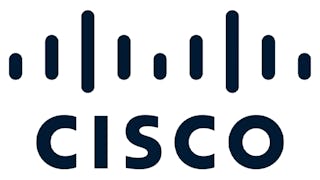This course offers a comprehensive exploration of advanced BGP routing scalability and performance techniques essential for managing large-scale networks. You will gain practical knowledge of migrating to and configuring BGP route reflectors to overcome the limitations of traditional iBGP full-mesh architectures, significantly reducing the number of required sessions while maintaining efficient route propagation. The course also covers Cisco IOS performance enhancements—including PMTU discovery, BGP PIC, BFD, NSF awareness, and route dampening—designed to optimize router CPU resources and accelerate network convergence.


要了解的详细信息

添加到您的领英档案
June 2025
39 项作业
了解顶级公司的员工如何掌握热门技能

积累特定领域的专业知识
- 向行业专家学习新概念
- 获得对主题或工具的基础理解
- 通过实践项目培养工作相关技能
- 获得可共享的职业证书

该课程共有4个模块
涵盖的内容
2篇阅读材料
In classic IBGP, the BGP boundary router needs to forward the route that is received from an EBGP peer to every other router within its own AS. This requires the use of a dedicated IBGP session for each router. Also, the BGP boundary router forwards routes that a router sources in the same way. The result is that a large number of IBGP sessions are required. BGP provides the route reflector feature to help to scale these sessions. Large BGP networks cannot properly scale without relying on performance-enhancing tools such as route reflectors. Route reflectors enable BGP routing information to be distributed in a way that does not require a physical full-mesh network. Implementation of such a network requires knowledge of the steps to properly migrate and configure route reflectors and the commands that are used to verify the operation of a configured network. This course introduces the steps that are required to successfully migrate an existing AS to BGP route reflectors. It also lists the Cisco IOS commands that are required to configure and monitor route reflectors.
涵盖的内容
10个视频11篇阅读材料11个作业
As the number of routes in the Internet increases, demands on router CPU and memory resources on the router in a service provider will increase. BGP processing affects both router resources and network convergence time. Network convergence must be as fast as possible to ensure accurate routing information between domains. Router resources also must be optimized whenever possible. Cisco IOS performance improvements for BGP are designed to aid network administrators in achieving these goals. In this course, you will learn about various Cisco IOS performance improvements that have been designed to reduce BGP convergence time. This course includes discussions of convergence, BGP routing processes, and the effects of BGP routing processes on router CPU resources. The course also discusses the commands that are required to configure and monitor BGP for various Cisco IOS performance improvements. Improvements that are mentioned are PMTU discovery, input hold queue, BGP PIC, BFD, BGP NSF awareness, BGP scan time, advertisement interval, keepalive, and hold-down timers.
涵盖的内容
12个视频13篇阅读材料13个作业
More than 600,000 prefixes are now on the Internet. Network administrators do not need or desire their routers to carry full Internet routing in many circumstances. Furthermore, protective controls are needed on customer-facing routers to ensure that a configuration error does not cause the accidental advertisement of prefixes from autonomous systems that did not originate them. BGP is designed for reliability and scalability. It has much flexibility regarding administrative policy controls, route selection, and performance tuning and scalability features. An advanced BGP configuration tool has been designed to improve BGP scalability and performance by reducing the number of prefixes that a router receives from a BGP neighbor. Scaling routers to meet the demands of full Internet routing and associated administrative policies requires protocols such as BGP with embedded scalability mechanisms. In environments where network administrators must configure many BGP peers, peer groups are a scalability tool that reduces both administrative overhead and router resource requirements. Typical service provider networks usually contain BGP-speaking routers that consist of many neighbors that are configured with the same administrative policies. These policies can be outbound route maps, distribute lists, filter lists, update source, and so on. You can group neighbors with the same update policies into peer groups to simplify configuration and, more importantly, to make BGP updates more efficient. In this course, you will learn about peer groups as a BGP scalability mechanism. Even when a BGP implementation is correctly configured and highly robust, the performance of the routing process on any given router is limited. Limiting the propagation of unstable routes, specifically when they are not beneficial to the network, becomes an important issue because it reduces the processing requirements of the router that is forced to process routing table state changes. Route dampening is a BGP feature that has been designed to reduce BGP processing requirements by minimizing the propagation of unstable routes to BGP peers. AS border routers, in any BGP implementation, cannot rely upon external peers to sufficiently shield the AS from routing table instability. Route dampening allows route instability to be contained at an AS border router that borders the instability. This course describes the purpose and operation of the route-dampening feature on Cisco IOS routers. This course also discusses the Cisco IOS commands that are required to enable route dampening, modify default dampening parameters, and release a route that has been suppressed because of dampening. Cisco IOS commands that are used to monitor route dampening are also discussed.
涵盖的内容
12个视频16篇阅读材料15个作业
获得职业证书
将此证书添加到您的 LinkedIn 个人资料、简历或履历中。在社交媒体和绩效考核中分享。
位教师

从 Networking 浏览更多内容
 状态:免费试用
状态:免费试用Cisco Learning and Certifications
 状态:免费试用
状态:免费试用Cisco Learning and Certifications

Packt
 状态:免费试用
状态:免费试用Cisco Learning and Certifications
人们为什么选择 Coursera 来帮助自己实现职业发展




常见问题
To access the course materials, assignments and to earn a Certificate, you will need to purchase the Certificate experience when you enroll in a course. You can try a Free Trial instead, or apply for Financial Aid. The course may offer 'Full Course, No Certificate' instead. This option lets you see all course materials, submit required assessments, and get a final grade. This also means that you will not be able to purchase a Certificate experience.
When you enroll in the course, you get access to all of the courses in the Specialization, and you earn a certificate when you complete the work. Your electronic Certificate will be added to your Accomplishments page - from there, you can print your Certificate or add it to your LinkedIn profile.
Yes. In select learning programs, you can apply for financial aid or a scholarship if you can’t afford the enrollment fee. If fin aid or scholarship is available for your learning program selection, you’ll find a link to apply on the description page.
更多问题
提供助学金,



